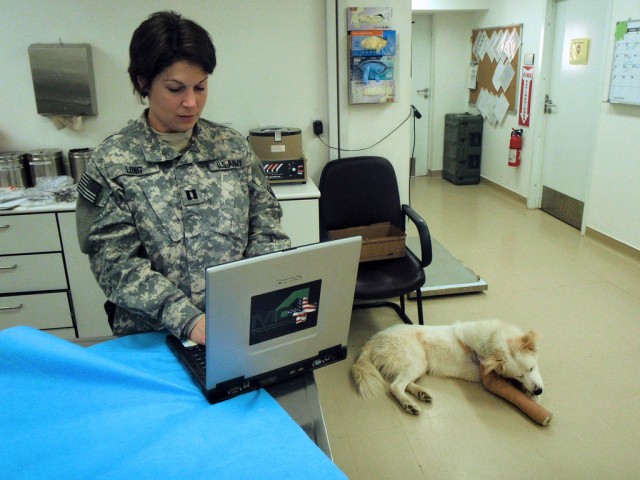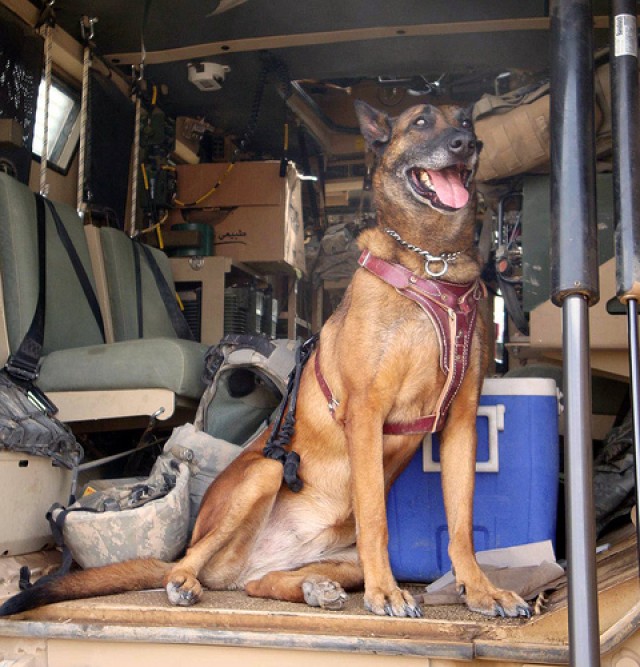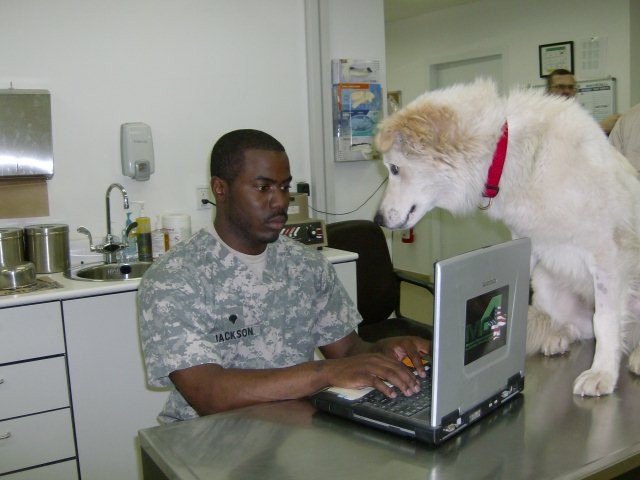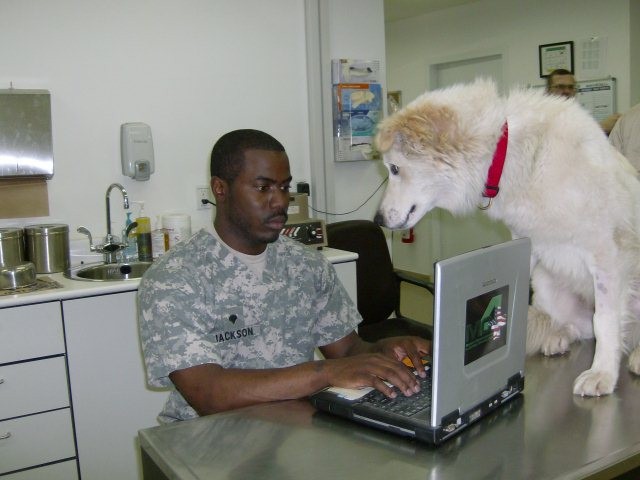Military working dogs (MWDs) play an important role throughout Iraq and Afghanistan. They sniff out explosives perform sentry duty, as well as contribute to the physical and mental rehabilitation of Service members.
Like their two-legged counterparts, these Soldiers visit local treatment facilities for medical care. One such clinic, operated by the 51st Medical Detachment (Veterinary Medicine) at Balad Airfield, Iraq, treats canines regularly.
There, veterinarians administer care for the local MWD population, seeing about 20 patients per week for wellness visits and sick call. The Balad clinic also treats many more animals with acute conditions, since it also serves as the level III referral treatment facility for every vet detachment throughout Iraq. As such, they provide services that smaller veterinary facilities are unable to perform, including surgery, radiology, laboratory services and intensive care.
Recently, the 51st Medical Detachment performed surgery on a dog that was shot in the face. While treating another patient from suffering acute liver failure with internal bleeding, doctors performed the first transfusion of fresh plasma for a canine in Southwest Asia (SWA). In the process, veterinarians worked with the apheresis section to extract plasma as part of the dog's treatment. Despite their hard work, the animal needed to be euthanized three days after it arrived at the facility.
In January, the Balad vets began documenting animal care electronically. They use the same system used by providers to chart the care for human war fighters-<a href="http://www.mc4.army.mil">Medical Communication for Combat Casualty Care (MC4)</a>.
Cpl. Maria Florez, noncommissioned officer in charge of the veterinary treatment facility at Balad, understood the benefits associated with electronic medical records (EMRs) and helped put the system into action.
"Military working dogs undergo a tremendous amount of movement in and out of theater, as well as support various missions," Cpl. Florez said. "It would be extremely beneficial for providers to access the digital records from any location. With the records stored in a central location, it could help to avoid records from being misplaced or lost while in transition to a new location or treatment facility."
While veterinarians deployed to theater could benefit from a central database of records for MWDs, the Balad facility is currently the only location electronically charting animal care. The staff currently uses a standalone system and is actively developing new business processes.
"We've had some growing pains as we learn to use the system," said Capt. Erin Long, officer in charge of the 51st Medical Detachment. "Veterinary clinics in garrison typically use a different program, so it is taking us some time to adjust and determine how the animal data properly matches the fields in AHLTA-T [outpatient medical recording application]. We're developing templates to help streamline the process and also to help standardize the data entry."
Sgt. David Panaway, noncommissioned officer for the 51st Medical Detachment in Balad, explains that the handlers receive paper copies of the records before they return to their home base. "It allows the local providers to see the care we administered and use the information should similar conditions reappear. Occasionally, handlers arrive at our facility without historical data and we have to call clinics in theater and garrison for the medical histories. The lack of information slows the treatment process."
Since the initial deployment of MC4 systems to SWA in 2005, vet detachments have explored the possibility of using EMRs in animal care. After various tests and internal discussions, units decided to continue with paper records.
The 72nd Medical Detachment at Bagram Airfield, Afghanistan, is the latest to look into the use of the EMR system. While the unit decided not to use the EMR functionality of the MC4 system, the 72nd Medical Detachment utilizes the medical logistics component to order medical supplies for their four-legged patients.
Although Capt. Long's efforts to digitally chart animal care remains an isolated incident in the larger picture of vet care, she believes that using MC4 in this capacity can help other vet detachments use the system in their clinics.
"We're helping to generate a medical history for the working animals we see in our clinic," Capt. Long said. "I'm very proud of what we have been able to accomplish to date. We have some more hurdles to cross before we're completely comfortable with the system and no longer use the pen and paper. I also believe that if we can be successful with our documentation, others will see that an option is available and in use. As a result, they may be less reluctant to incorporate the system into their clinics."






Social Sharing